Everything You Need To Know About Underwater Scooters

Diving deep into the depths of coral reefs and seeing an abundance of marine life is such an amazing feeling. As you dive deeper and the reef appears from the depths, you are in awe with the hundreds of species of fish and coral you see just a few feet away. But of course, you only have so much bottom time. Whether you’re snorkeling, freediving, or scuba diving, your time is always limited by the oxygen you have in your lungs or tank. If only you could increase your bottom time while exploring what really seems like a whole different world.
With underwater scooters, you can! Underwater scooters are designed to give you the ability to zip through the water with ease. Using less effort in swimming and conserving oxygen will enable you to stay underwater longer and explore more of the deep blue sea. Since the first underwater scooters were created over 80 years ago, hundreds of different versions have been designed to perfectly fit every user’s needs. From beginner snorkelers, to advanced technical divers, to military usage there is a scooter for everyone.
What is an underwater scooter? What is a DPV (Diver Propulsion Vehicle)?
An Underwater Scooter, also called a Diver Propulsion Vehicle (DPV), Underwater Propulsion Vehicle, Sea Scooter, or Swimmer Delivery Vehicle is a mechanically propelled vehicle that pulls people underwater to reduce the effort of swimming. Underwater scooters enable scuba divers, snorkelers, and free divers to move through the water with less energy exertion and less oxygen usage. Depending on the model, they can be used by children snorkeling or by advanced technical divers navigating a large wreck or deep cavern diving.
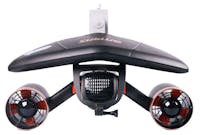
Our RecommendedScooters and Accessories
When to use an underwater scooter (Diving, Snorkeling, Freediving, etc)
You can use an underwater scooter for so many different kinds of diving! There are a wide variety of scooters in a wide range of prices that have varying features. Whether you are snorkeling in 8 feet of water and want some support getting down to and staying on the bottom for a longer period of time, or exploring a 500ft long ship in 150ft of water, there is a scooter for everyone. Underwater scooters can be used by snorkelers off the beach or by scuba divers navigating a large wreck, reef, or underwater cave. Underwater scooters are an excellent choice for a beach dive so that you don’t waste so much energy and oxygen just getting to the dive site. Imagine if you didn’t have to kick so hard for almost half a mile to get to the SS Copenhagen. You could easily get pulled by your underwater scooter with minimal effort. Just hold on and enjoy the ride!
How does an underwater scooter work?
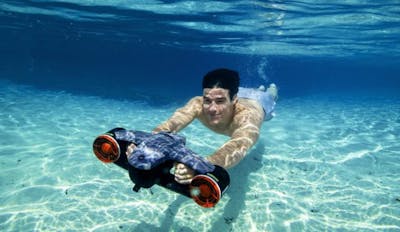
It’s quite simple actually! Take your scooter in the pool, spring, beach, or open ocean and fly by other swimmers and divers like Aquaman! Underwater scooters use battery powered propellers to propel people through the water with ease while swimming, snorkeling, or diving. Simply grab the handles, and use your body to steer as they navigate a wide variety of different seascapes. There are some variations in each scooter, some you will hold on to with both hands, some only require one hand, and some require no hands at all, but the idea is the same.
Origin of underwater scooters
The origin of the underwater scooter dates back all the way to World War II. The Italian Navy created manned torpedoes carried by ships and submarines that could be launched near a target. Two divers would ride the torpedo towards the target, attach a warhead, and then ride away before detonating the explosive so that they could safely get out of range of the explosive’s blast. After the Italian Navy used these DPVs to successfully infiltrate the British harbor of Alexandria in 1941, the British then designed their own versions called “chariots” in 1942'. Over 20 years later in 1965, a DPV was even used in the James Bond film, Thunderball. Now that’s one way to feel like a secret agent in the water.
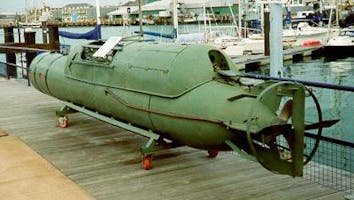
A wide variety of underwater scooters (from beginner snorkeling to advanced technical diving)
With so many different options, picking an underwater scooter can seem like quite a challenge. Are you looking to have fun with your kids in the pool or at the beach? Are you looking to improve your bottom time and distance as an open water diver? Or Are you an advanced technical diver looking to increase your exploration of large wrecks and underwater caves? Ask yourself what you will want to use your underwater scooter for, and then choosing the perfect scooter will become easy.
At Divers Direct we sell a few different scooters to best fit your needs. The Sublue WhiteShark MixPro Underwater Scooter for example is a lightweight, compact scooter that is an excellent choice for the pool or snorkeling, but also great for freediving or scuba diving. This scooter includes a float that is removable so that you can use it on the surface, or dive down to 131ft! Some scooters have an automatic shut off function if it is accidentally let go. This can be a great option for children who may struggle or forget to hold on. An incredibly portable underwater scooter is the Tovatec SeaSurge Underwater Scooter which is extremely lightweight, weighing less than 8 lbs and can dive up to 130 ft deep. For under $1000 and with a run time of up to 90 minutes, this can be an excellent choice for an avid freediver, snorkeller, or a diver who wants to navigate a reef a little easier and conserve oxygen. One of our fastest scooters here at Divers Direct is the Sublue Navbow+ Underwater Scooter which features 3 different speeds that can take you up to 2 meters per second at a depth of 131ft. Featuring customizable depth and distance alarms, and a run time of 60 minutes, your scooter will notify you when you may need to start heading to the surface. An additional OLED display will even help you read all your important information even in low light conditions. Make sure you do your research and consider some options before making your purchase.
Maintenance
When hopping off the boat after a long day underwater exploring miles of coral reef, you will have to clean your DPV like any other piece of dive equipment. To ensure your scooters last and perform as they should, it is important to take care of your DPV. Flushing out the propellers in freshwater, as well as spraying your scooter and its battery down is important to desalinate them to help prevent corrosion. Fill a large bucket or bin with freshwater and run the propeller for 20-30 seconds. Don't forget to hold on! Brushing the gunk off of your scooter can also give your scooter the clean look it deserves and helps ensure no gunk gets stuck in places it shouldn’t. You can also take your scooter to a service center where they can fully disassemble your scooter for a much deeper clean. Some service centers will go all the way to the electronics and motor compartment where they can blow it clean with compressed air and make sure there is no buildup of carbon.
Buoyancy
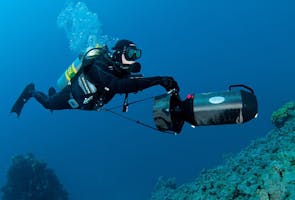
“Going up?” As a diver, buoyancy is very important for controlling your movement, bottom time, and most importantly keeping yourself, the reef, and marine life safe. Most scooters are designed to be neutrally buoyant so that they will neither float or sink, and stay wherever you leave them. Others can be negatively buoyant for deep water diving, or positively buoyant for snorkeling so that they stay at the surface when diving down freely. Some more advanced scooters allow you to adjust the buoyancy to fit your diving needs. This can be useful when navigating wrecks or caverns. The Sublue WhiteShark MixPro Underwater Scooter for example has a removable float so you can use it on the surface or while diving. When selecting your scooter, make sure it has the buoyancy capabilities you desire.
Safety First
Safety should always be your #1 concern when doing any kind of aquatic activity. Before using an underwater scooter for the first time it can be well worth it to take a DPV course. You can learn the ins and outs of scooter construction, pre-dive check procedures, and how to actually dive with a DPV. One must always be careful when ascending with a DPV. You must always make sure to do so slowly to avoid getting decompression sickness. Especially when snorkeling or freediving, you should not go deeper than you would without a DPV. As part of your pre-dive check, you must also inspect your scooter. Make sure the housing is tightly secured to avoid flooding. Check to ensure the battery is full. You don’t want to be carrying your scooter to the surface, it should be carrying you! Always dive with a buddy. If your scooter malfunctions, you can tandem their scooter back up to the surface to look at the problem a little closer and safely. The scooter itself can produce a rather annoying sound that may scare off marine life, so be courteous of other divers and marine life when operating an underwater scooter.
Maintaining trim with your scooter
When using an underwater scooter, you must make sure you are weighted correctly and have the right amount of air in your BCD. If you have too much weight or air in your BCD, you will cause drag resulting in higher air consumption and a shorter dive time.
Equalizing while operating a scooter
As we have discussed, there are many different models of underwater scooters. Equalizing while operating an underwater scooter can be difficult with some models. Be wary of how you equalize and which scooter best suits your technique. Some divers can equalize hands-free, while others may need one or even two hands to do so. There are single-hand operated DPVs like the SuBlue Navbow Underwater Scooter as well as hands-free scooters that will allow you to use these techniques.
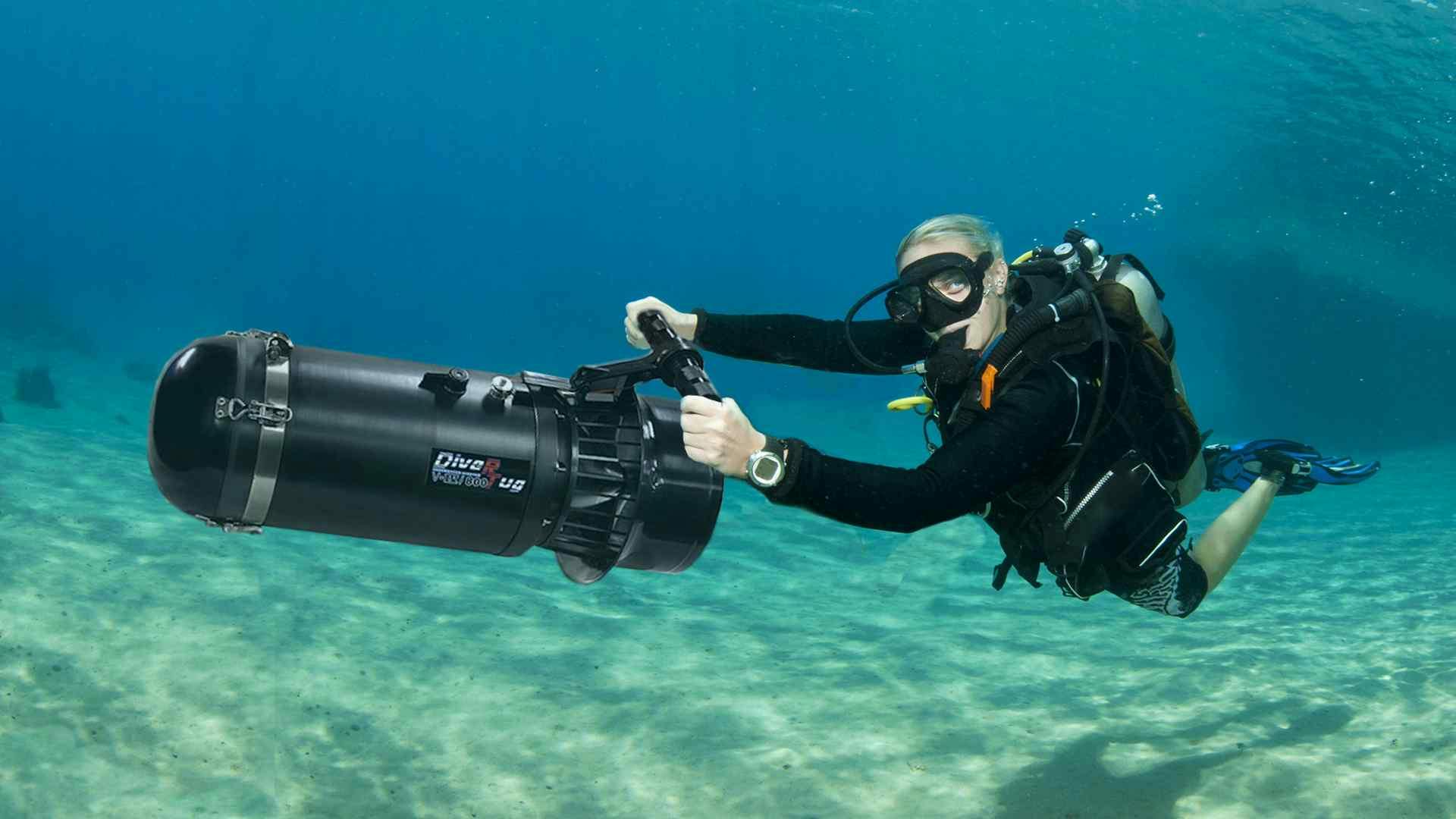
Choosing the best scooter for your needs
Are you diving into the great depths of the Spiegel Grove Dive Site, exploring the 30,000ft of mapped passageway in the Devil’s Eye cave system, heading out on a shore dive to Turtle Reef in Deerfield Beach, FL, or just snorkeling at John Pennekamp in shallow water? Each of these wonderful adventures would require a different underwater scooter to best support its needs. When you are selecting the best underwater scooter for you, you should take into account the run time, battery life, and maximum depth rating to make sure you choose the right scooter to fit your needs. You must also consider your experience, how much you want to spend, and how fast and deep you want to go. Some scooters are specifically designed for the type of water they are used in or the diving you plan to do. Scooters made specifically for saltwater may be less buoyant in freshwater and pools. They may even sink, so make sure to do your research before selecting your scooter.
Written by: Steven Fandl
FAQs
How much does an underwater scooter cost?
There are a wide range of underwater scooters with varying prices. A scooter’s price can range from a few hundred dollars like the Sublue WhiteShark MixPro Underwater Scooter to over $17,000. Some scooters will also have customizable options such as a camera or light mount that can also affect the price.
How deep can they go?
Some scooters can go well over 200 ft deep! Others are limited to 15 ft deep. This all depends on the scooter you choose. Make sure to do your research on the best option for you when selecting a scooter.
How fast can they go?
It depends on the scooter! Most scooters range from 3 - 6 mph, but there are scooters that top out at around 4.5 mph like the Sublue Navbow Underwater Scooter, and scooters that can reach speeds of up to 12 mph.
How long is the battery life/run time?
On average, most scooters have a run time of around an hour, but some scooters can run for as little as 30 minutes or even up to 4 hours.
How much does an underwater scooter weigh?
Some scooters can weigh as little as 3 lbs which is great for kids or beginner snorkelers. While some advanced, heavy duty scooters can weigh near 50 lbs.
Can kids use underwater scooters?
Yes kids can use underwater scooters with supervision, and there are specific scooters designed for kids. They are typically lightweight and designed for shallow water diving.
What happens if I let go of my DPV while it is running?
This is an excellent question that most first time scooter users have. Many scooters have an automatic shut off function that will cut off the motor if you let go. However, some do not have this. Make sure to read about the scooter you are purchasing to ensure a safe and enjoyable dive.
Can you take a sea scooter on a plane?
Many scooters can be taken on a plane, but they must meet all the requirements. This can depend on the size of the scooter or the type of battery the scooter uses. It is important to review the specifications of your specific scooter before considering bringing it on the plane.





